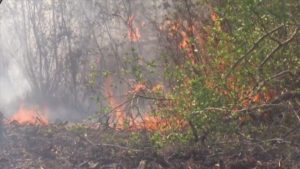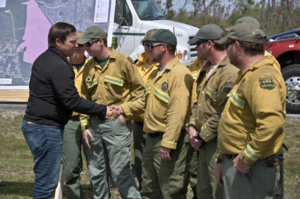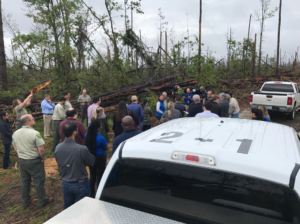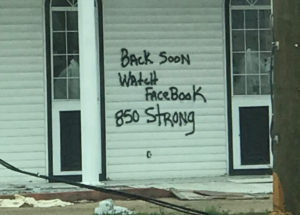Wildfires burn as the Governor blames Congress for inaction

Some of the 600+ acre wildfire in Bay County, March 31, 2019
Timber debris left behind by last October’s Hurricane Michael fueled a 600-acre wildfire last week in rural Bay County east of Panama City , in what state officials fear will be the first of many. Governor DeSantis and Agriculture Commissioner Fried in separate visits to the region called for Congress to immediately pass delayed recovery funding to help mitigate the fire danger, as insured and economic loss estimates were revised significantly upward.
Governor DeSantis said Congress “needs to stop playing politics” and pass a disaster relief package that’s been pending in Congress for months. The measure provides $13.5 billion in aid for Florida and other southeastern states hit by hurricanes and for areas of California hit by wildfires last summer. The package was blocked last week in the Senate by those wanting more money for Puerto Rico recovery from 2017’s Hurricane Maria.

Governor DeSantis thanks firefighters in Bay County, April 3, 2019
The Governor said the money is needed in part to help mitigate the Panhandle’s wildfire danger from the estimated 72 million tons of debris – a lot of it downed trees – left from the Cat 4 hurricane. The Governor honored the men and women of the Florida Forest Service for their efforts over five-days to contain the fire near Allanton which was drenched later in the week by rains. Twenty homes had to be evacuated at one point.
Citing “the grave need for more resources” Governor DeSantis extended the state of emergency declaration in 14 counties for another 60 days.

Agriculture Commissioner Fried and a legislative delegation tour area of Hurricane Michael damage in Calhoun County, April 5, 2019
Later in the week, Agriculture Commissioner Nikki Fried and a bi-partisan group of state legislators visited rural Calhoun County about 30 miles north of Panama City to see the damage first-hand. A big farming and timber area, Fried said farmers are suffering and don’t have the money to clear their land in order to replant.
“This is something that can’t wait anymore. The federal government needs to make sure this isn’t a partisan issue. People’s lives are suffering every single day and this needs to be a priority, not only for our state but for our country,” Fried said on the drive over from Tallahassee.
The timber industry alone has taken an estimated $1.2 billion hit from the storm. Bills in the legislature so far fund a little more than half of the $39 million Fried has requested. The state has spent about $1.6 billion responding to the storm, most of which is expected to be reimbursed by the federal government.
Meanwhile loss estimates from Michael have been revised upward. Some analytic firms put insured losses as high as $11 billion, up from initial projections of $8 billion. Analysts note that older construction in the region and ineffective newer construction didn’t hold up to the peak 155 mph winds, nor did they fully anticipate the agricultural losses from the storm. Total economic losses could now top $25 billion.

A deserted storefront in Bay County, January 7, 2019
After several reporting periods with $200 million jumps in insured losses, the Florida Office of Insurance Regulation’s latest numbers are in a lull, now at $6.15 billion, up $50 million from its previous 15-day report. Insurance company claims total 145,000 with an 81% closed rate, at a 5:1 paid to unpaid ratio.
There is concern that even for those with insurance checks coming, some Panhandle residents may not be able to afford to rebuild their homes. Stricter building codes are being put into place in several communities. In Mexico Beach, ground zero for Hurricane Michael, the city council is requiring new homes be built 1.5 feet above expected flood waters in a 500-year storm. For some properties, that means raising a home from 2 feet to 12 feet above its pre-storm elevation. All new homes must also be built to withstand 140 mph winds, up from the previous 130 mph requirement. Nearly half of the coastal community’s 1,700 homes were destroyed or substantially damaged in the storm.
LMA Newsletter of 4-8-19

